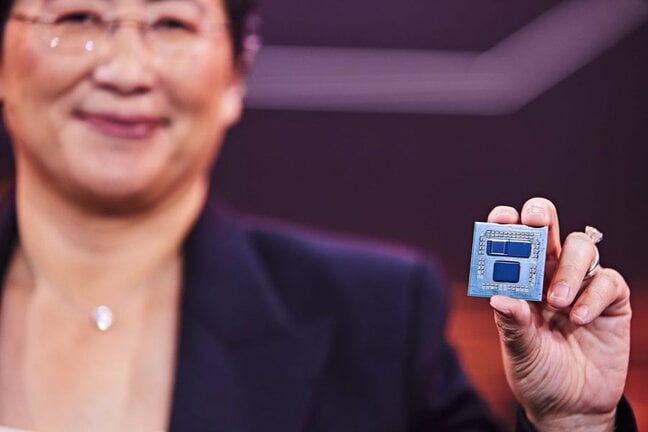AMD has revealed a new 3D chip stacking technology it claims delivers the equivalent performance boost to a new generation of chip architecture.
The new tech was revealed in a keynote address to the virtual Computex exhibition delivered by AMD president and CEO Doctor Susan Lu, who said the tech bonds “64MB of 7nm SRAM cache directly onto each core complex, effectively tripling the amount of cache feeding our Zen3 cores.”
Signals and power pass across silicon, and Lu said the result is more than 2TB/s of bandwidth with superior thermal performance, a 200x improvement in interconnect density and 15 times better density than other chip stacking technologies.
AMD’s approach to stacking uses a direct copper-to-copper bond, instead of silicon microbump tech used by other players. One result of this approach, Lu said, is that AMD uses a third of the energy required by rivals.
Lu said the tech is currently targeted at gaming and will go into production on AMD’s highest end products by the end of 2021.

AMD CEO Lisa Lu with a Ryzen CPU that uses 3D V-cache technology. Click to enlarge
“It averages 15 percent improvement at 1080p just from 3D V-cache,” she said, showing off an unspecified 5000-series Ryzen CPU built with the tech.
The CEO pitched 3D V-Cache as "bringing the best to high-performance computing", Lu offered no detail on when, or whether, the tech might appear in silicon tuned for applications beyond entertainment.
Lu also touched on new desktop processors, including a new “G” and “GE” range of Ryzen Pro silicon. The half-dozen new machines boast either four, six, or eight cores, and base clock speeds from 3.4GHz to 4.0GHz. The CEO also revealed a pair of new processors for the enthusiast market, in the form of the Ryzen 7 5700 G and Ryzen 5 5600G, each of which integrate Radeon graphics and Zen 3 cores.
Desktops and business users were, however, very much an afterthought in the keynote. Lu’s focus was on gaming laptops, and she delivered news of a new “AMD Advantage design framework” that offers a spec that lappie-makers can slap on their hardware to inform gamers they’ve done what AMD says is necessary to make speedy machines.
The CEO also revealed new Radeon RX 6000-series graphics cards for laptops, without a hint they may make their way into mobile workstations.
AMD’s EPYC server CPUs were given the opening few minutes of Lu’s presentation, and she used that segment to trumpet their performance when compared to Intel Xeons.
Lu felt like she was going through the motions during that section but radiated more enthusiasm when revealing that the infotainment systems in the Tesla Model S and Model X are powered by a Ryzen chip, including AMD’s RDNA 2 graphics architecture.
RDNA 2 has also made it into future designs of Samsung’s Arm-based Exynos system-on-chips. Lu said future Exynos models will “feature custom AMD RDNA 2 architecture-based graphics IP that brings raytracing and variable rate shading capabilities to flagship mobile devices.”
Lu said Samsung will reveal its RNDA intentions soon. The Register has heard Samsung emphasise 120Hz screen refresh rates in its flagship devices as delivering a great gaming experience, even in its business-oriented Note devices, so expects the Korean company will use its AMD alliance to again position its devices for entertainment applications. ®
https://www.theregister.com/2021/06/01/amd_computex_3d_v_cache/


















